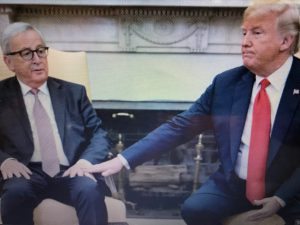The framed photo of General George S. Patton’s grave marker had these words scribbled across a corner: “Dear Donald, let’s remember our common history.”
And so, on July 25, 2018, one President handed a gift to another President.
European Commission President Jean-Claude Juncker gave the present to American President Donald Trump. The written remarks were from Juncker.
Prior to arriving in Washington DC amidst a firestorm of controversy over trade and the even greater threat of broken relations between the United States and Europe, Juncker had decided to give the photo to Trump. Probably, Juncker’s action was the result of a group’s discussion. My guess is that the decision was made toward the end of Juncker’s preparatory meetings. The analysis likely centered on whether and how to meet with Trump and, once there, what to offer and request in return. The photo and writing feel to me like either a kickoff notion or a capstone idea: “Let’s (start or end) the event with a poignant flourish.” And so the airplane flying Juncker and his entourage to the United States also carried the framed photo in the baggage.
A symbol. An emblem. A gesture.
We often use history in this way, as a token meant to summarize the lives of many people, the passage of many years, the expanse of many miles. Our notion is to pound history into something small and white-hot with clarity. We plunge it into the water, sizzling. We bring it out once more, hardened into a meaning. The Giver then hands the item over to the Receiver in the hope that both will share the knowledge and the interpretation. Therein lies the key word pairing: both/share. Giver and Receiver must understand for the gift to have its greatest value.
Without the understanding, history as a small item is nothing more than a small item with no history.
Juncker’s hope is that Trump will recognize that American blood has moistened European land. More to the point, I believe Juncker—or someone advising Juncker—predicts that this particular American’s blood will seize the attention of this particular American commander-in-chief; they may assume Trump feels an affinity for an American general known to be tough, hard-charging, and ever-victorious. Going further, they may also assume that Trump’s preference for images and imagery, rather than pages of facts and policies and theories, will make the gift an important tool in the dialogue. Perhaps they’re right. We should hope so.
My interest here isn’t political. I just wanted to raise in your own mind the idea of how history is frequently expressed and exchanged in smallish forms—the symbols and emblems and gestures. I expect your organization might have an award named after someone well-known in its past. I expect you may have picked up a small souvenir of a trip to an historical site. I expect you walk or drive by a lonely sign about a noteworthy person, place, or event. Tokens one, tokens all.
They belong to the family of actions embedded in Juncker’s gift.
Maybe you’ll come to a moment when you’re trying to communicate an important thought or point to another person or group. Think about the past as a source for your communication. Buried within the past might be a tiny relic that you can unearth and offer as a token of your intent and vision.
Thanks for reading. All the best, Dan









